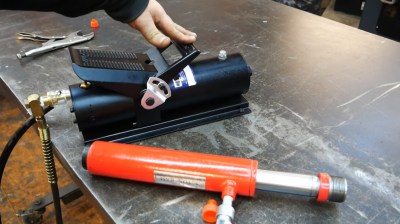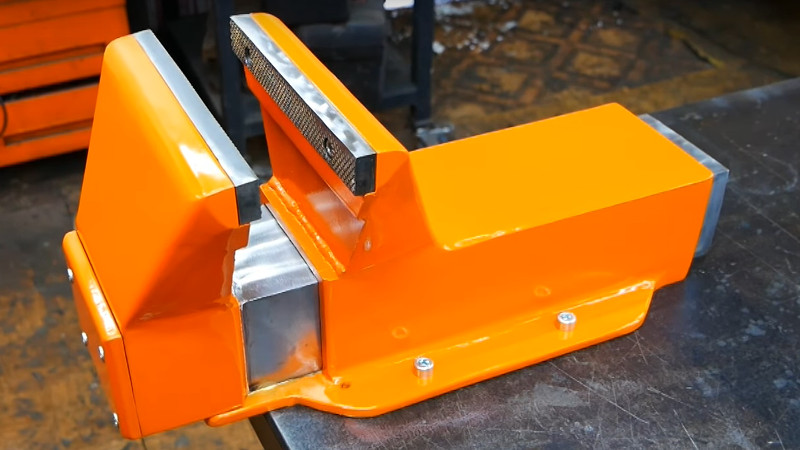When we sit down to a build video and see that it’s from [Workshop From Scratch], we know it’ll be a good one, full of plenty of gratuitous metal-wrangling with the promise of an ingenious and useful take on a workshop essential at the end. The home made hydraulic bench vise is the latest from that particular workshop, so settle down with the video below the break for a treat.
 Unlike the lead screw we’d expect from a more conventional vise, this one uses a hydraulic pull cylinder and its associated compressor which is powered by compressed air. A substantial vise frame is constructed around the cylinder from thick steel plate, with some careful welding and grinding to ensure a smooth finish. The result is substantial clamping force with a very smooth and quick action, which doesn’t overhang the edge of the bench in the way a more traditional one does. The hydraulic tube is tucked away through a hole in the bench, and the foot-operated pump lies out of sight on the floor.
Unlike the lead screw we’d expect from a more conventional vise, this one uses a hydraulic pull cylinder and its associated compressor which is powered by compressed air. A substantial vise frame is constructed around the cylinder from thick steel plate, with some careful welding and grinding to ensure a smooth finish. The result is substantial clamping force with a very smooth and quick action, which doesn’t overhang the edge of the bench in the way a more traditional one does. The hydraulic tube is tucked away through a hole in the bench, and the foot-operated pump lies out of sight on the floor.
Looking at this vise with blacksmith-trained eyes, it raises the question of how it might perform were something in it to be hammered. Overhanging vises are vulnerable to splitting when hammered, so there’s the possibility that this one with its flat mounting might fare a little better. Either way it would be an asset to any workshop.
When it comes to vises, [Workshop From Scratch] is where we saw that magnetic vise earlier last year.

















India makes a pretty affordable vice, out of all those decommissioned cruising ships that we get to see run-aground on YouTube. I’ve absolutely brutalised mine, yet it’s still fit for purpose, years later. It just lacks the trueness, and smooth action of a high quality British antiquity.
The vise is a tool with jaws, but vice is wickedness. Sometimes spelling matters.
This is true.
Well spotted, though probably glaringly obvious to the more erudite than I.
No, that’s not right either. Hrmph!
Ah, ‘antique’. That’s better.
Both are spelled ‘vice’ for those speaking the King’s english
The serial hydraulic vise maker. Seen this before. Like twice here
Is it vice or vise?
Or visa-versa?
Vice-versa, the most wicked among Nissans.
In the UK “vice” and “vise” are both spelled “vice.”
Mind your fingers! I’m thinking that you start crushing, then press the wrong way on that foot valve….
It’s not per se the rigidity and heft of construction that would worry me for hammering, or other tasks requiring application of sudden and varying forces, it’s that you’ve basically got things clamped by a spring, like an air shock. You know how an air shock works, you hit it, it gives. There is no positive locking in sight. It would have been better to just have a weak cylinder to run the jaw of a conventional vice in and out quickly with the lock disengaged, so you could drop it down, apply half a turn maybe and have actual clamping happen.
It’s a hydraulic cylinder, not a pneumatic one. Compressed air just runs the pump that squeezes out the hydraulic fluid. Still, there would be no feel for load, although hopefully before you have squashed all of your fingers you will have learned to correlate clamping force with hydraulic pump sound. A pressure gauge would be a useful addition.
This is so unsafe, at least use a 3 position hold to run footswitch.
Can’t feel how hard the vise is squeezing. I don’t want to crush whatever I hold and generally don’t want it to just fall out. There’s no finesse.
The way it is mounted means you can’t clamp large parts vertical, the reason for a large overhang on a regular vise.
Nice gimmick but it will never perform like a real vise , such as a Heuer or Gressel.
A nicely made and exceedingly heavy vice (yes, that’s how I’m going to spell it – I’m from the tea loving country), is an excellent and proper tool.
My one is only 6″. Wish it was bigger.
What’s that liquid he’s using to cool the drill? Lmao
It’s more a variant of hydraulic press than a vise.
Most hydraulic vise use an hydraulic dual size piston actuated by a regular screw.
This way you can multiply force and still have manual feeling of the clamping force.